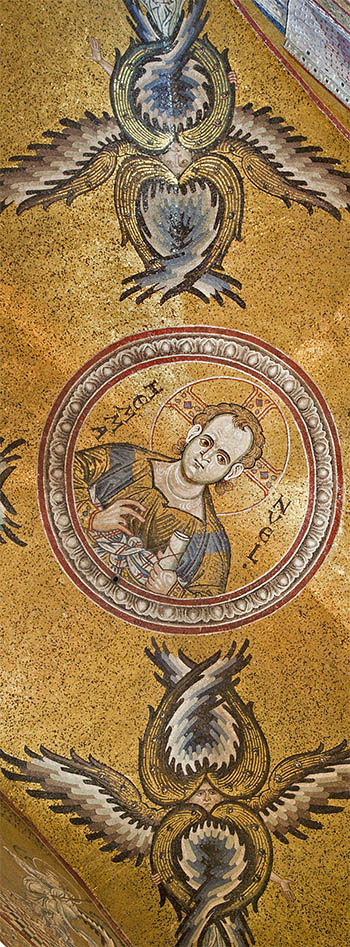
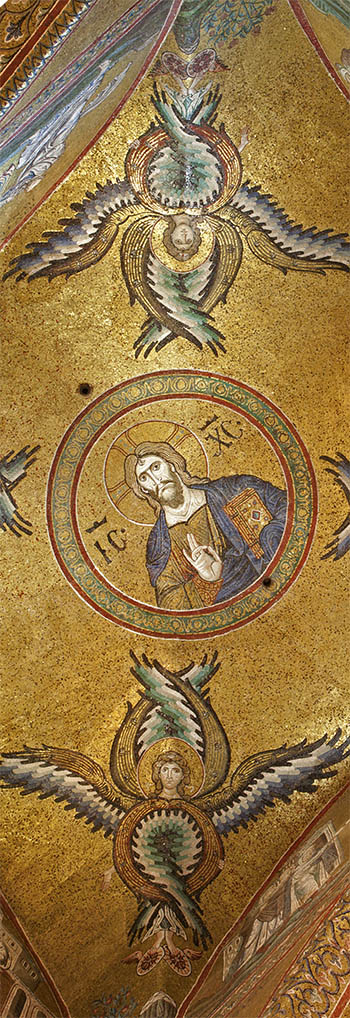

Two Graffiti Drawings in the Church of Hagia Sophia in Constantinople
christina savova – thomas thomov - sofia
The term medieval graffiti is commonly used to refer to all marks carved on stone, and more rarely on wood. People made them to acknowledge their existence and faith in significant and mainly sacred places. They are not colorful but they reflect life in all facets and in different forms: personal notes and memoranda, depictions of sailing ships, animals, weapons and coats of arms, as well as portraits and abstract geometrical patterns. Graffiti are mirrors of ways of living and thinking and the churches were not always quit spiritual place. So, they were both accepted and acceptable. Church authorities seemed to have tolerated them and graffiti tended to be kept rather than erased.
Medieval graffiti are a relatively untouched subject. There are many that have never been studied, documented, or even acknowledged. Plenty of them were destroyed, either deliberately or accidentally, and their conservation is neglected and poor. It is only recently that the interest in medieval graffiti has been growing.
One of the places with abundance of graffiti is the Great Church or the Church of the Holy Wisdom – the famous sixth-century domed church, which was built by emperor Justinian the Great. It was considered to be one of the wonders of the world and the most important religious edifice in the city of Constantinople. Hagia Sophia was a focus of God’s blessing with tales of wonders and miracles, well-known beyond the borders of Byzantium. The graffiti in the aisles are not numerous but the marble revetments, balustrades, window-frames, doors and columns of the galleries have been engraved with mementos in several languages. Most people are not aware that Hagia Sophia offers examples of graffiti dating back to hundreds and hundreds of years. As a matter of fact, they may be compared to a buried in a backyard medieval library. In the Great Church, graffiti comprised inscriptions in various languages, as well as some drawings. These inscriptions provide first-hand information on the evolution of languages, the history and development of particular scripts, as well as some non-professional writing practices. Despite of their historical value, scholarly literature still considers them a minor source of information. Some of the drawings are crude and schematic, others are remarkably detailed. The first drawing, which is 18 cm in width and 21 cm in height, is located at the east part of the south aisle of the church and at the south side of the soffit of the bema arch. It is lightly engraved at about 160 cm above the door. The position of the drawing is rather unusual: instead of the common vertical one, this one is situated horizontally (Photo. 1). Graffiti, portraying complete Christian scenes, are an extremely rare find.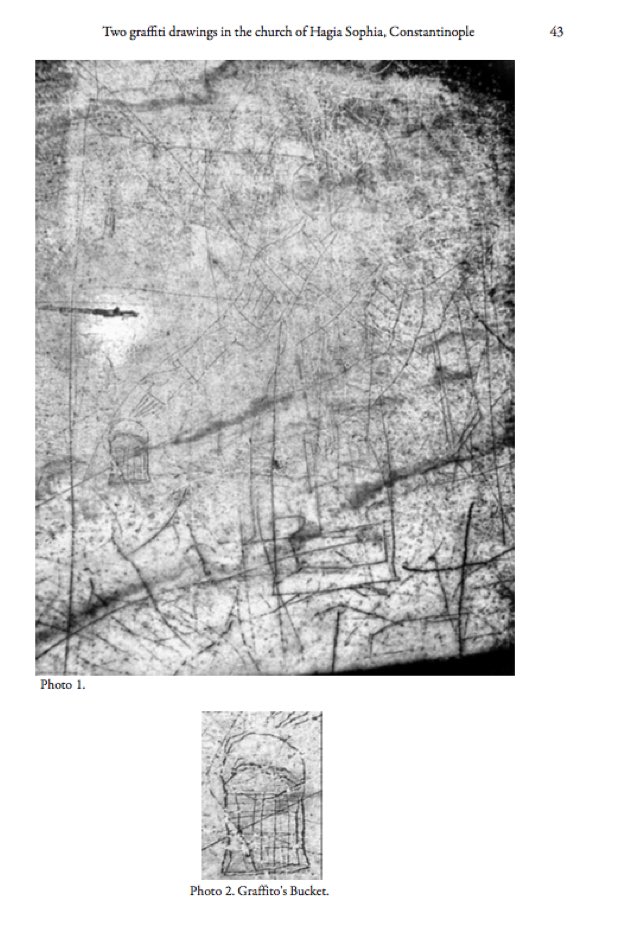
In 1908 Е. M. Аnthoniadis published himself own drawing of the graffito to with a short commentary. Unfortunately, it lacks several important details related to the attire and the head of the figure, which leads to its wrong identification as a young deacon.
In 2010 Thomov inspected the drawing in the south aisle of Hagia Sophia and took some new photographs and corrected some details. It is a carefully painted full-length figure of a youth in a solemn pose. (Fig. 1) He is clad in a court costume with the traditional crossed loros on top. There is a staff (or a baton) in his left hand, and his right hand points to a vessel with a handle. His thick curly hair is gathered round the head in thick plaits and falls down the back of his neck, his fringe is V- shaped and the ends of a ribbon flutter behind his head. The oval and symmetrical face reveals a strong character. The eyes are large, the nose is sharp and rather straight, the lips are thick and the chin is round.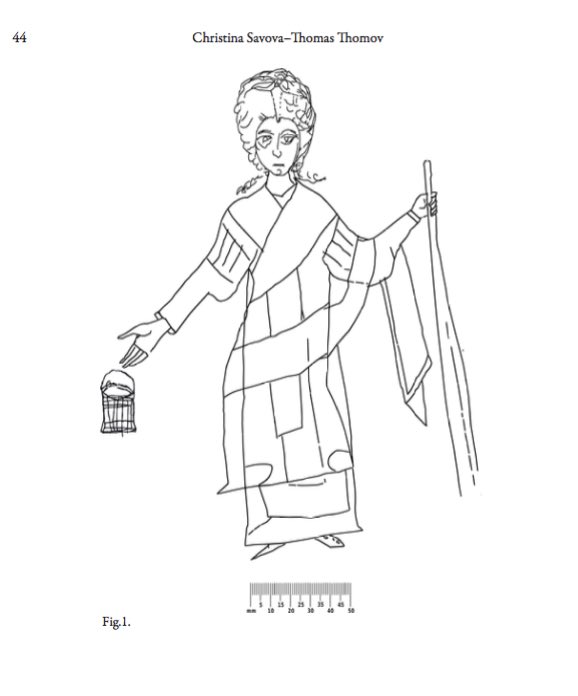
His long-sleeved undergarment (divetession?) goes down to his feet. The sleeves are quite wide in the upper arm, but are pulled in and caught at the elbow with a narrow cut at the wrist. e lower hem of the tunic is edged with decoration and from the fact that it is carried upwards at the sides, we can take it that the artist wanted to show that sides of the tunic are open or slit at the bottom in order to facilitate walking. The slit is edged with a stripe ending in a circular segment. His top garment (sakkos?) is to his calves, the sleeves are short, loose and to the elbow. They are hemmed with bands. the shoes are decorated with small circles and their toes show. The traditional crossed loros – a very long scarf – is draped diagonally over both shoulders, one end hanging to the lower hem of the outer tunic, and the other end wound around the waist in a complicated way and hanging over the left arm. The frontal pose of an image is considered to be a symbol of spiritual communication between the effigy and the onlooker. However, for the medieval spectators the image was actually a representation of apparition.
In our opinion, this is undoubtedly a depiction of an archangel. The first and foremost argument is the abundant curly hair with hair fillet, whose ends are seen on either side of the neck. One can easy distinguish it in the graffito drawing. Actually, archangels never wear a crown. Their hair is adorned with a textile band. Diadems like loros have an ancient origin. Emperor Constantine the Great (324–337) opted to wear the Hellenistic diadem, a simple, tied at the back headband that is associated with Alexander the Great, who was the first to wear it as an exclusive symbol of his succession to the empire. Subsequently, the emperors and the priests wore it as a sign of their high secular or spiritual power. Constantine seized upon the symbol to emulate the great conqueror. In Byzantium, however, it was transformed into a round or semicircular headpiece of jeweled panels with hanging precious stones and pearls called pendulia.
The second argument is the loros, since it is a specific characteristic of archangels, as well as a way to distinguish them from other angelic orders. We can assume that for the person, who created the graffito, it was necessary to emphasize that fact. The earliest example of attire change from chlamys costume to the ceremonial loros costume dates to the period immediately after the end of Iconoclasm in the 9th century. For example, the angelic orders like Dominations and Powers, represented in the bema of the Dormition Church at Nicaea (after 843), now destroyed, were dressed in crossed loros costumes. According to М. Parani the widespread image of the angelic orders (especially the archangels) in loros costumes is an innovation of the Middle Byzantine period. During the Middle and Late Byzantine periods the archangels were portrayed in the crossed loros, or what we know as the simplified loros worn in the same way but richer in design. From the mid-10th century onward, the crossed loros with a loose collar round the neck, a short end hanging in front and the longer wrapped round the waist, had been superseded by the modified one. We should take into consideration W. Woodfin’s statement that archangels continue to appear “in loroi” in the late Byzantine and post Byzantine art often in the same contexts as angels in liturgical dress”.
To sum up: the graffito figure in Hagia Sophia is dressed in loros of a rare and antiquated type, which was not worn by Byzantine emperors since the eleventh century. is contributes to the perception that it is a depiction of an archangel.
The next interesting detail is the staff. When an archangel appears in a frontal pose, especially in iconic representations, he holds a staff or labarum inscribed with the trisagion in one hand, and the globe, surmounted by or closing a cross, in the other. During the late 9th and 10th centuries, the staff served as an insignia of the officials who were responsible for keeping order during imperial ceremonies, or of those who served as messengers or spokesmen.
What were the garments worn under the loros? The most common type in the Middle Byzantine period was a full-length tunic with long sleeves. It was richly decorated with ornaments round the hem, the collar, the cuffs, and arms. The sleeves, as in our case, are usually quite wide, but are pulled in and caught at the elbow. According to M. Parani, what appears to be a Middle Byzantine development was the substitution of arm-bands for the square or circular attachments on Early Byzantine tunics. In the tenth century Book of Ceremonies (De Cerimoniis), which is a kind of dossier containing earlier documents and more recent materials, this garment was identified as divetission. It seems to have been worn on top of the undergarment with wide arms reaching not quite to the wrists. It is clear that the armbands composed of small rectangles are ornamental decoration of the sleeves of the over-garment.
We can also refer to the angelic orders represented in the bema of the Dormition church at Nicaea (after 843), now destroyed. They wear shorter tunics over longer ones with modest ornamentation at the lower hem. (Fig. 2) However, the shape and decoration of the overtunic are hidden by the enormous loroi. Emperors Constantine and Justinian I are dressed the same way on the mosaic panel over the southwest vestibule portal of Hagia Sophia from the mid-tenth century. (Fig. 3) Another example is the mosaic of king Roger II in the church of St. Mary of the Admiral in Palermo (dated 1146–1147). (Fig. 4) In this case, the decoration of the under-tunic below the calves is unpretentious and the lower hem of the over-garment is richly ornamented. It is apparent that the designer of the mosaic was guided by a pictorial model from an earlier period. According to E. Kitzinger, a small ivory relief in Moscow from the mid-10th century reflects “almost perfection of the prototype from which the design of the mosaic derives”. (Fig. 5)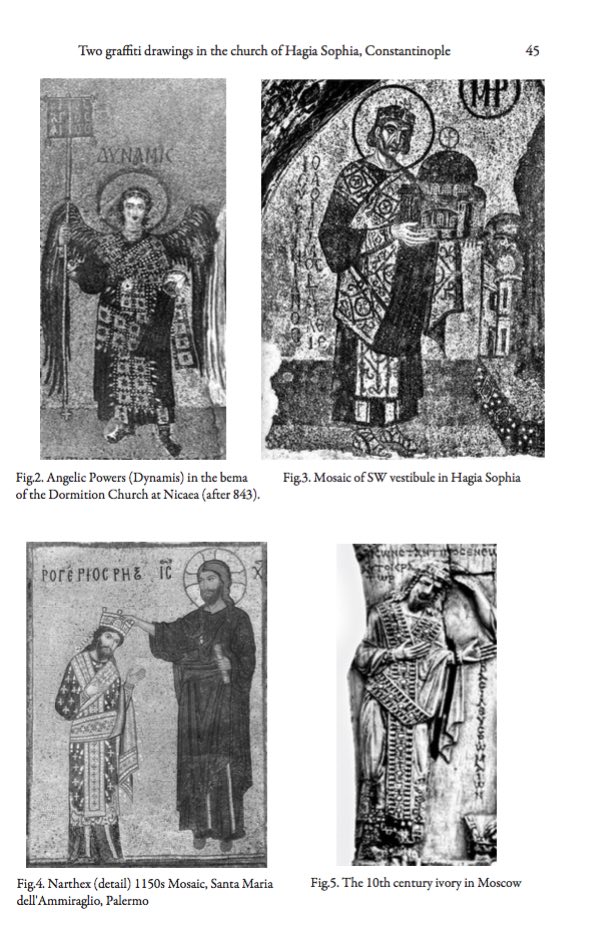
Finally, a pair of shoes, decorated with small circles, can be seen beneath the hem of the tunic. One can assume that the circles must be an imitation of pearl decoration, or an indication that what was represented in the graffito did have some relation to reality after all. The imperial shoes were one of the most characteristic elements of the emperor’s costume despite their relatively small size and inconspicuous position.
In the words of C. Mango, the imperial iconography of archangels never appears in narrative scenes, either biblical or hagiographical, and the royal attributes appear only in static or ‘iconic’ images. H. Maguire has convincingly suggested that during the 9th and the 10th centuries, ‘imperial’ angelic orders were incorporated in the decoration of the bema – they formed the honorific guard of the Virgin with or without the Child, or they participated in the theophanic prophetic visions in the apse. For this reason, their attitude is not one for adoration and as it is indicated by the inscription of their labara, they participate in the timeless and never-ending glorification of God by the angelic orders. We can also and the images of archangels in imperial costumes in the entrance, the naos, the altar and the dome. A glance at our graffito reveals that archangels have no royal attributes i.e. a globe and labarum.
The vessel next to the archangel’s right side is the most enigmatic thing in the drawing. There is a reason to suggest that it may be considered somewhat special. It is worth noting that in the Vatican codex vat. Copt. 9 (dated 1204/5) Archangel Michael is shown in a similar pose. (Fig. 6) A century ago, Е. Аnthoniadis stated that it is “possibly a casket with holy relics”. To disprove this view, it is sufficient to refer to the ivory casket in the Palazzo Venezia, Rome, dated to 898 or 900. (Fig. 7) Moreover, it is virtually impossible to find such a casket neither among the preserved medieval artefacts, nor among its pictorial representation in the medieval art. Besides, if we take into consideration that the mosaic image of Archangel Gabriel is placed on the south side of the bema arch, we can conclude that he is actually depicted in the graffito drawing. In some cases he holds in his right hand a “lantern with a candle” as one of his main attributes. Unfortunately, it is impossible to sustain such an identification for the vessel in our case.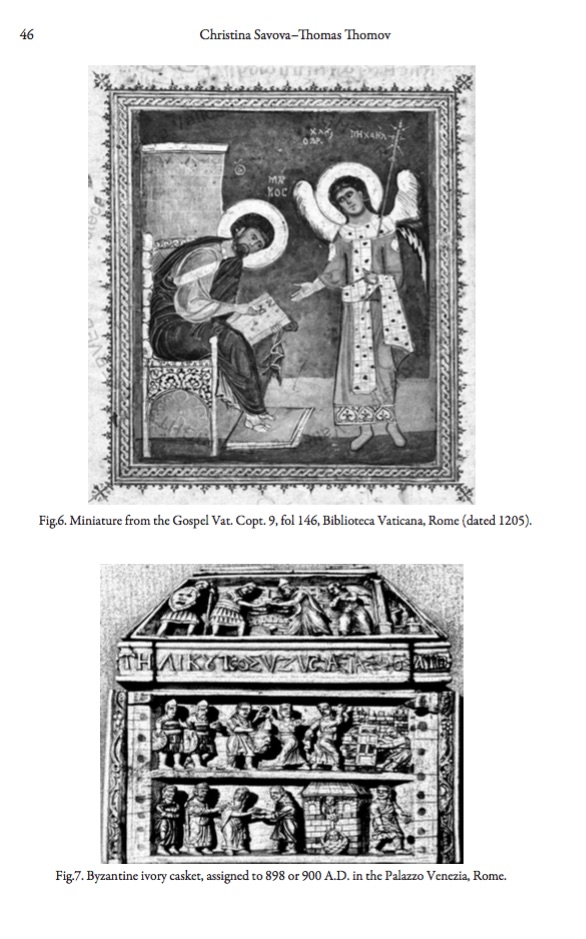
It might be a reliquary bag, although the shape of the handle is not compatible with the preserved medieval artefacts and depictions in the pictorial art. Or it might be a moneybag, which was a symbol of the imperial donations to the church, a sign of imperial generosity and piety. As it is well known, after having received the Eucharist, the emperor would proceed with his entourage through the south gallery and through the door to the Holly Well. Here he would present his moneybag to the archdeacon and to various officials of the church, and possibly to representatives of the poor. But if we compare the shape of the vessel to the imperial mosaics in the south gallery of Hagia Sophia, we would certainly reject the moneybag suggestion.
The next possibility is a basket. At first sight, it bears great resemblance to the graffito image. One can easily find similar examples from both Byzantine and Western European iconography. But what is the vessel’s purpose? What immediately comes to mind is a basket of bread as it is attested, for example, in the Biblical scene of the angel’s visit to Gideon. (Fig. 8, 8a) But in scenes, such as “The Lamentation” and “The Descent from the Cross”, the basket is placed in the foreground, irrespective of whether it was filled or empty. What seems certain is that its basic function is to be a basket of tools. In support of this assumption, we may refer to an eleventh-century Byzantine ship, which was discovered in 1973 off the south coast of Asia Minor at Serçe Limani. According to the archaeological report, “any of the woodworking tools were found in a basket in the stern, along with a sharpening stone and an assortment of nails”. So, if this container is a basket of tools, we have one example connecting it with an archangel: the well-known story of Archangel Michael’s apparition to the boy guarding the tools for the building of Hagia Sophia.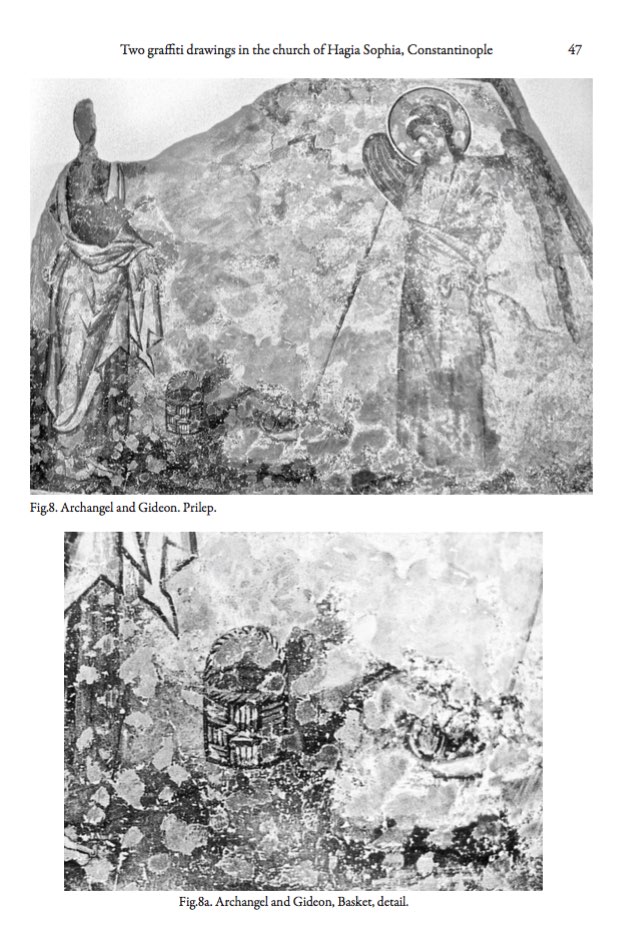
As a matter of fact, we might be looking in a wrong direction. Quite simply, if we take a closer look at the graffito, we can conclude that there is a certain difference between it and the traditional basket in pictorial art. It is easy to discern that the basket’s structure (the willow rods and the multi-strand diagonal of the basket) in pictorial art representations is shown as rectangular segments shaded with vertical and horizontal lines or friezes of small triangles. However, there is not a shred of evidence of them in our case. Bearing this in mind, we believe that the container is a wooden bucket with metal hoops. (Photo 2) Perhaps the closest similar image can be found in the portrayal of the old shepherd in the Nativity in the church of St. George at Kurbinovo on Lake Prespa (1191). (Fig. 9, 9a). For this reason, it would be a mistake to sustain the idea of its identification as a situla, or a bucket holding holy water. (Fig. 10)
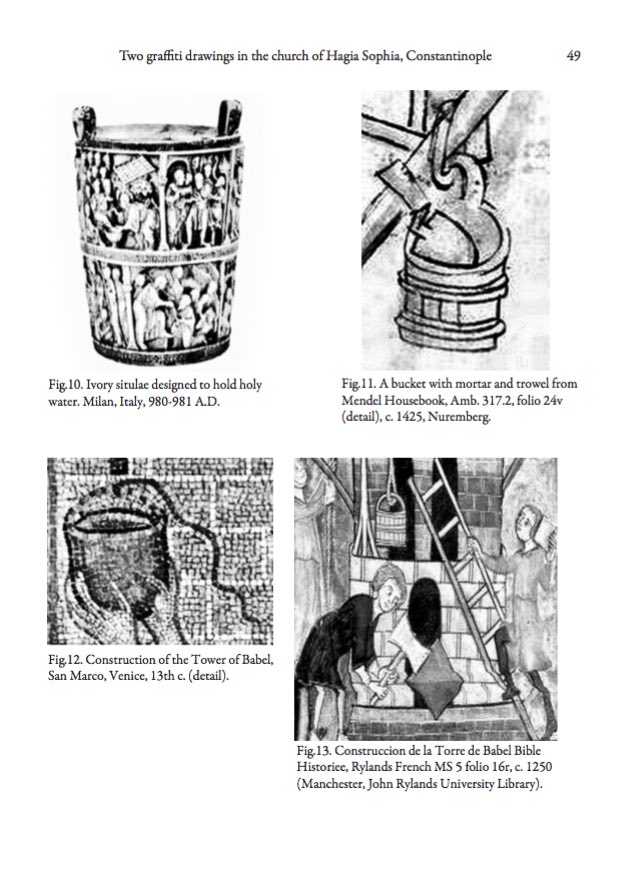 The bucket is often found among building implements – it was used for thinning the daub, sand, and mortar. (Fig. 11) In addition, the majority of buckets depicted in painting are shown in the process of church building, and a number of them are in biblical illustration of the building of the tower of Babel. (Fig. 12, 13) There is also another paradox: tools are rarely seen in Byzantine pictorial contexts with the notable exception of agricultural and writing implements. One can add that the story of the building of Hagia Sophia does not specify the types of the building implements. Therefore, their depiction is left to the artist’s imagination. The anonymous artist may have introduced a realistic element or a bucket in our graffito as a way of expressing individuality in a culture where iconographic choices were limited by the need for recognizability.
The bucket is often found among building implements – it was used for thinning the daub, sand, and mortar. (Fig. 11) In addition, the majority of buckets depicted in painting are shown in the process of church building, and a number of them are in biblical illustration of the building of the tower of Babel. (Fig. 12, 13) There is also another paradox: tools are rarely seen in Byzantine pictorial contexts with the notable exception of agricultural and writing implements. One can add that the story of the building of Hagia Sophia does not specify the types of the building implements. Therefore, their depiction is left to the artist’s imagination. The anonymous artist may have introduced a realistic element or a bucket in our graffito as a way of expressing individuality in a culture where iconographic choices were limited by the need for recognizability.
Let us return to the building history of the church, which was transformed into an interesting tale. During the construction, strange miracles took place and the Church had a special angel to guard it. The tale – Diegesis – about the construction of Hagia Sophia, was translated into various languages and can be found in a number of texts. It even appears in a Russian version in the 13th and the 14th centuries. There is no doubt that this story with enormous popularity needed some depiction. The choice of Аrchangel Michael is not so strange, since he is associated with number of early cults featuring gender ambiguity. Only two archangels – Michael and Gabriel – had their own firm place in popular devotions. All others, including Raphael and Uriel, appear mostly in prayer and in incantations of an occult character. Michael appeared before the boy as a beautiful youth in a shining garment (εὐνοῦχος λαμπρὰν ἐσθῆτα ἠμφιεσμένος) and is described as someone sent from the palace. The boy was thought to be a eunuch but later it became apparent that he was not among the court eunuchs. The visitor’s shape changed and the emperor realized that he was not a eunuch but an angel. He was a messenger of God, who was sent to inform the emperor about God’s desires regarding the name of the church. What is important for the narrative is that the angel has promised to guard the church until the boy returns. As the boy is sent into exile, the angel becomes the guardian angel for Hagia Sophia. According to C. Mango, whenever angels and archangels make themselves manifest in the Lives of the Saints and other edifying texts, they do it under the guise of eunuchs or imperial cubicularii, and not that of emperors i.e. with loros and globe.
То summarize, our graffito shows the climactic moment of the story in Diegesis when the archangel remained to guard the building tools and became the permanent guardian of Hagia Sophia. Obviously, there is a certain connection with the mentioned bucket in the central point of the graffito and it may have been chosen by the author because of its use in the process of building. Therefore, it is not in disagreement with the story. Moreover, the skilled artist does not merely follow the imperial iconography of the archangel, i.e. he holds a staff instead of a labarum, the globe is lacking and the depiction of the loros is just a sign to distinguish him from the other angelic orders and to show us that this is the image of an archangel. The staff in his hand emphasizes his role as a messenger of God’s will. Besides, it is important to mention that St. Michael is God’s administrator for heavenly a airs and God’s messenger. It is not unexpected that the official iconography does not include similar scenes61. However, the graffito artist has enjoyed a great deal of latitude and has shown his own conception. Also, his drawing was on the south side of the soffit of the bema arch, and it forced him to place his drawing in horizontal position and not in the traditional vertical one. is is why it was not easy to be discerned. When we look at our graffito, we realize that the archangel is not depicted as a participant in the timeless and never-ending glorification of God by the angelic orders, but as a guardian of the church in a slightly different image and place. e most conspicuous characteristic of our drawing is the close connection with the narrative. It is worth mentioning that there is no chance to find a depiction of a guardian angel in the 11th century Byzantine art. According to V. Lazarev, the “guardian” of the church of Hagia Sophia (mentioned by G. Florovsky) is no other but Archangel Gabriel, also confirmed by the location. Besides, the place may well have been chosen by the anonymous artist because of the proximity to a colossal figure of the archangel in the apse mosaic. Nevertheless, this is only a hypothesis in need of a further evidence to be accepted as a historical truth.
As to the date of the drawing, it is very difficult to give a precise date to a graffito without some clues in the inscriptions or some specific details. What seems certain in our case is that the graffito was created some time a er the monumental apse mosaic of Hagia Sophia from 867 with the images of the Virgin and the Child between Archangel Gabriel and Archangel Michael (nowadays almost invisible). As already mentioned, it is impossible to date the graffito based only on the attire decoration of the figure. It is more than obvious that the graffito’s hair arrangement above the forehead is very similar to that of the archangel in the apse mosaic from the second half of the 9th century. (Fig. 14) Another close parallels to our graffito are the right angel or ΔΥΝΑΜΙΣ, represented in the bema of the Dormition church at Nicaea (after 843), and the tenth-century fragment of an ivory plaque with Archangel Gabriel in the Dumbarton Oaks Byzantine Collection. (Fig. 15, 16). The time span most probably lies between the second half of the 9th century and the 10th century. One can also add the specific combination of the garments, which seems typical for the time before the end of the 10th century.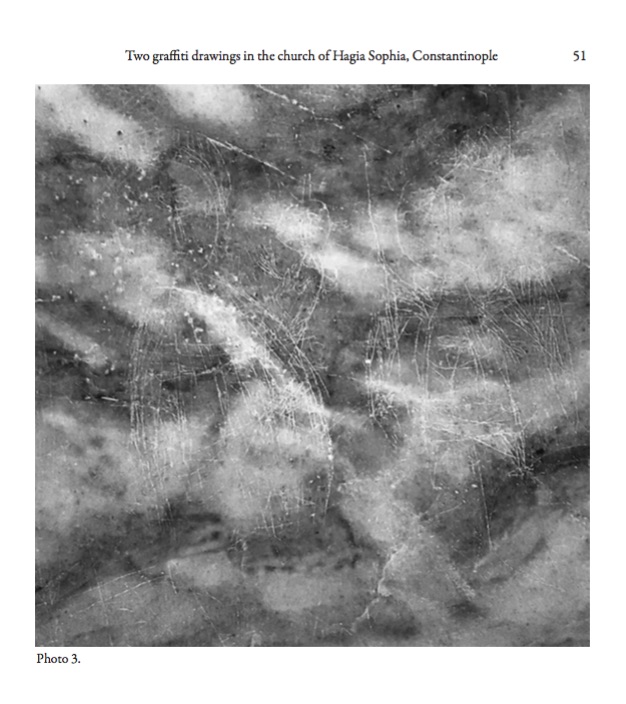
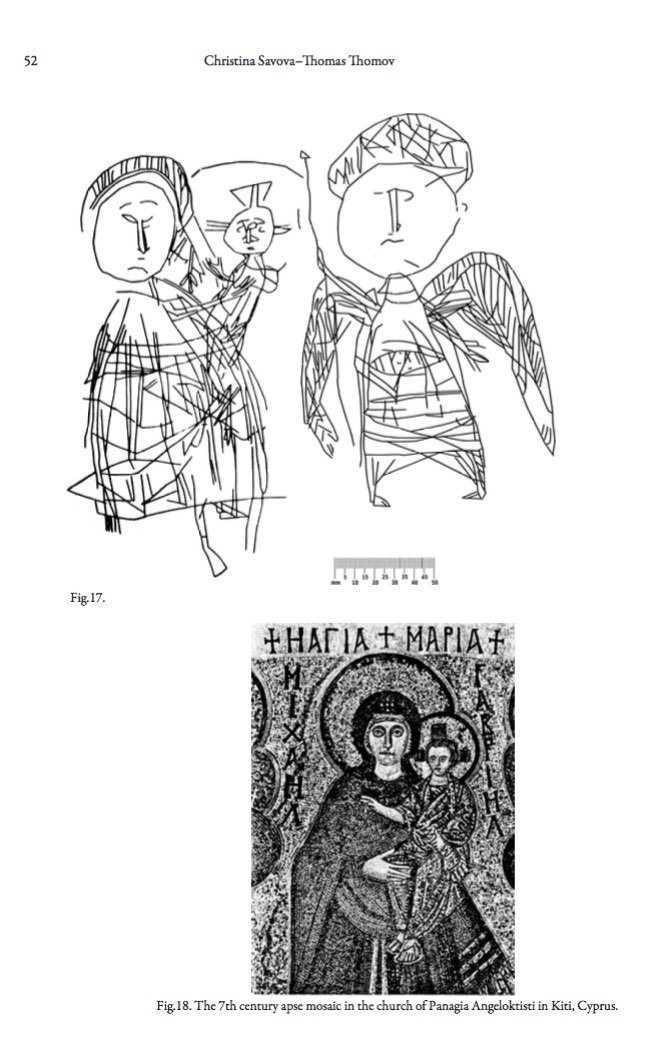
In the graffito drawing, we witness the work of a skilled artist, who did not simply reproduce what he had seen on the apse mosaic. He must have been familiar with the angelic iconography. On one hand, he attempted to portray the realities surrounding him, and he replaced the archangel’s chlamys costume from the mosaic of Hagia Sophia, which was rarely noticed in Middle and Late Byzantine contexts, with the crossed loros costume. On the other hand, the author may have introduced realistic elements as a way of expressing individuality in a culture where iconographic choices were limited by the need for recognizability. The result is a new and very personal vision of Archangel Michael based on a popular tale like Diegesis. In other words, taking into consideration the pose and the hair and clothes arrangement, the graffito dates from the second half of the 9th century to the end of the 10th century, which is a relatively short time span.
The second graffito, which is 25 cm in width and 21 cm in height, is also located in the south aisle of the church. It was engraved on a marble wall plate on the right side of the last door leading to the south-west end of the inner narthex. Its creator was apparently kneeling because it is lightly engraved at about 80 cm above the floor. (Photo 3; Fig. 17)
The graffito is very rough, and is it hard to distinguish any details. However, if we take a closer look, we see that it displays an image of the type of the standing Virgin Hodegetria where the Theotokos holds the Christ Child with her left arm and points to him with her right arm. An angel is relegated to the secondary position, standing on the left hand of the Theotokos. He has no imperial attributes, not even the popular halo. The Virgin is depicted in a three-quarter view to the right but her face is turned more towards the spectator. In contrast, the figure of the Archangel is depicted frontally and without imperial attributes including the commonly shown halo. The nimbus is also omitted from the head of the Theotokos. On the other hand, Jesus has a “cruciform nimbus” or the cross inside of the halo over his head. e cruciform nimbus is only used for Christ and rarely for someone else in the Trinity. The figures in our graffito are shown with schematic faces without any distortion. However, the hands are drawn in a very simple, childish way. In the images of the Theotokos and her Child, one can find more details – palms with four fingers, legs in the right position (the left leg of the Child is simply marked) or some footwear (of the Theotokos). The image of the Archangel is represented by elementary primitivism. The anonymous author’s drawing of the Archangel’s wings is very detailed because of his desire to illustrate and make vivid each and every single feather. It is difficult to distinguish the clothes of the Child and the Archangel. As for the Virgin Mary’s dress, the author shows his intention to follow the style of the established iconography. The Theotokos wears a short hatched tunic with a V-shaped collar. In all probability, the use of the hatch was a technique to show the traditional blue colour of the dress. As a headdress she wears a kerchief concealing her hair and revealing only the lobe, and a decorated with bands maphorion. e latter, edged with a triple pendant, descends on the left side of the head and slants behind the figure of the Child reaching the waist of the Theotokos. She looks at the viewer and points with her right hand to the Christ child. us, she presents her Son to the world, while they both gaze thoughtfully at each other.
The Child Jesus sits upright supported by Mary’s left arm. His right hand is raised in blessing and he holds a scroll in his left one. These distinguishing characteristics signify that the Child is both the pre-existent Logos (the scroll) and the coming Saviour (the blessing sign). e author has attempted to follow the peculiar iconography of the Child and to depict his raised right hand as a sign of blessing. However, he misinterpreted the gesture and drew the right hand with an open palm. Moreover, the graffito gives us the impression that the scroll is depicted in the hand of the Virgin Mary just because Jesus’ left hand is not seen. As for the Archangel, he is holding a spear in his right hand, while the open palm of his left hand is turned upside-down. His thick and hatched hair is falling down the back and has the shape of a present day beret. In spite of all mistakes, the author’s intention was to depict the Mother of God in a standing pose known as Hodegetria, gesturing with her right hand toward her Child, who sits upright on her left arm holding a scroll. This type of Hodegetria, probably flanked by two angels, was a well-known preiconoclastic motif. It is a pity to see only the guard on the left side or Archangel Gabriel. The 7th century apse mosaic in the church of Panagia Angeloktisti at Kiti, Cyprus, is the closest parallel to our graffito. (Fig. 18)
Theotokos Hodegetria is the type of the “portrait of the Virgin” traditionally believed to have been painted by S. Luke, and to have been sent from Jerusalem to Constantinople in the 5th century most probably by the Empress Eudoxia. It was one of the most widespread and easily recognizable iconographic images of the Virgin Mary in the Byzantine art. It features the Virgin carrying the Child in her le arm and gesturing to him with her free right hand. He answers to her intercessory prayer by raising his hand in blessing. The Greek word Hodegetria, meaning she who shows the way, refers to the raised position of the hand. e designation did not, however, originate from a gesture of the Virgin herself but rather from the famous icon of the Virgin in the Hodegon Monastery in Constantinople. It took its name from the monks who led blind pilgrims to a miraculous spring that was believed to restore sight. Starting in the 10th century, a new image is formed. It presents the Virgin Mary gesturing towards the Child with a loosened embrace. The new visual impression emphasizes the dogmatic or theological relationship in the way Mary pleads with and offers Christ. And as a matter of fact, this is the image that should be identified as the Hodegetria. It has always been discussed as an iconography that emerges in the sixth and seventh centuries on icons and imperial seals.
For us, the important question is to identify the image, which was used as a prototype by the anonymous author. There are two possible variants: the images within or outside the Hagia Sophia. The most suitable place for supervision on the apse is located on the right side of the great porphyry column or on several steps from the wall with our graffito. Of course, the viewer could not see the archangels at both sides of the apse. On the ground of the newly discovered graffiti drawing at Hagia Sophia, we come to the conclusion that they are a reflection of what their authors saw within the church – a mosaic or a concrete detail from the church ritual. Strangely enough, if the graffito relies on Christian iconography, it follows established strict rules for the church image decoration. In other words, the pure fantasy was replaced by careful supervision. This leads us to another question: whether the apse mosaic has always displayed a representation of the Mother of God seated on a throne.
Alas, the discussion about the date of the creation of the apse mosaic and the pose of Virgin Mary has continued for decades without any resolution. As already mentioned, the majority of scholars believe that the mosaic dates some time after the end of Iconoclasm, or in the third quarter of the ninth century. We shall not recount in detail the arguments of the authors against this date. It is sufficient to note only two of them. According to the first one, G. Galavaris, the apse must originally have a standing Hodegetria, which by the late tenth or early eleventh century, or soon a er the earthquake of 989, was replaced by a representation of the Mother of God seated on a throne. On the other hand, Nicolas Oikonomides was puzzled by certain discrepancies between the description of the image of the Mother of God in Photios’s homily and the actual mosaic in the apse of Hagia Sophia. Photios describes her as standing, while the mosaic depicts her seated. It is assumed that the Photios’s text refers to the sanctuary mosaic, and supporters of an early date attribute the discrepancy to the “fluidity of the Byzantine language”. Advocates of a later statement are С. Mango and Е. Hawkins, who are also followers of R. Jenkins.
More recently Zaza Skhirtladze has pointed out that the representation of the Mother of God seated on a throne was in the church’s apse during the late 11th or early 12th century. The main arguments supporting the author’s claim is the hexaptych (six-paneled) Menologion with bilingual – Greek and Georgian – inscriptions, created in the late 11th or early 12th century by the Georgian monk Ioane Tokha. According to Skhirtladze, however, this does not rule out the possibility that “the original image was a standing Hodegetria, that was replaced in the late 10th or early 11th century with an image of the Mother of God on a throne”.
It certainly looks like the authors of graffiti used to represent things seen inside the church. Therefore, we can conclude that the original image in the apse was precisely a standing Hodegetria.
It should be also remembered that during the 9th and the 10th centuries, ‘imperial’ angelic orders were incorporated in the decoration of the bema – they either represented the honorific guard of the Virgin with or without the Child, or they participated in the theophanic prophetic visions in the apse. Thus we are dealing with the 9th or the 10th centuries, and judging by the iconography of our graffito one can date it to this time.
In summary, we have two exceptional graffiti drawings from the church of Hagia Sophia. Apart from being a valuable source regarding the church, they certainly help us understand and interpret much better the thoughts of the medieval people and the way they expressed them through art.

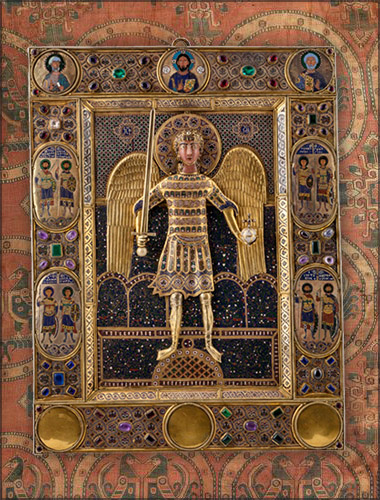


 click here for icons of christ
click here for icons of christ click here for icons of the theotokos
click here for icons of the theotokos click here for icons of angels
click here for icons of angels click here for icons of saints
click here for icons of saints








